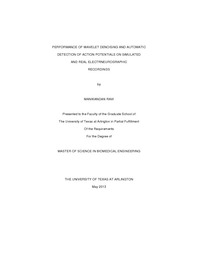
ATTENTION: The works hosted here are being migrated to a new repository that will consolidate resources, improve discoverability, and better show UTA's research impact on the global community. We will update authors as the migration progresses. Please see MavMatrix for more information.
Show simple item record
| dc.contributor.author | Ravi, Manikandan | en_US |
| dc.date.accessioned | 2013-07-22T20:14:18Z | |
| dc.date.available | 2013-07-22T20:14:18Z | |
| dc.date.issued | 2013-07-22 | |
| dc.date.submitted | January 2013 | en_US |
| dc.identifier.other | DISS-12151 | en_US |
| dc.identifier.uri | http://hdl.handle.net/10106/11851 | |
| dc.description.abstract | About 1 in 200 people living in the U.S have had an amputation at some stage in their lives. Development of neurally controlled artificial limb prosthesis with the ability to finely control motor activity continues to prove difficult for researchers in the field. One approach is to use the signals obtained from the peripheral nerves by placing an intraneural electrode in the nerve. Since this signal is very noisy, much of the useful information is either lost or buried in the noise even after FIR filtering. Furthermore, there is a need for fast, automated detection of action potentials in order to assess the neural activity in real time. This study analyzes the performance of wavelet denoising using Discrete Wavelet Transform and Stationary Wavelet Transform against FIR filtering by analyzing noise reduction, detection sensitivity and detection error in simulated electroneurographic (ENG) signals and real ENG recordings. Also, this study compared the sensitivity and detection error between manual detection and automatic detection using template matching technique on Finite Impulse Response filtered as well as Discrete Wavelet Transform denoised ENG signals. Furthermore, this study also evaluated the effect of choice of wavelet and level of decomposition (parameters of wavelet denoising) on noise reduction, sensitivity of detection and detection error to determine the optimal parameters for wavelet denoising of ENG recordings. From the results of this study, it can be concluded that wavelet denoising of ENG recordings reduce the noise significantly better than Finite Impulse Response (FIR) filtering (p-value = 3.11 E-06). Also, Automatic detection on Stationary Wavelet Transform denoised signals provided optimal sensitivity and detection error than all other detection modes compared. Among all wavelets and levels of decomposition compared in this study, five level decomposition with `symlet 7' wavelet provided optimal noise reduction and sensitivity of detection while also providing significantly lower detection error. | en_US |
| dc.description.sponsorship | Behbehani, Khosrow | en_US |
| dc.language.iso | en | en_US |
| dc.publisher | Biomedical Engineering | en_US |
| dc.title | Performance Of Wavelet Denoising And Automatic Detection Of Action Potentials On Simulated And Real Electrneurographic Recordings | en_US |
| dc.type | M.S. | en_US |
| dc.contributor.committeeChair | Behbehani, Khosrow | en_US |
| dc.degree.department | Biomedical Engineering | en_US |
| dc.degree.discipline | Biomedical Engineering | en_US |
| dc.degree.grantor | University of Texas at Arlington | en_US |
| dc.degree.level | masters | en_US |
| dc.degree.name | M.S. | en_US |
Files in this item
- Name:
- Ravi_uta_2502M_12151.pdf
- Size:
- 2.552Mb
- Format:
- PDF
This item appears in the following Collection(s)
Show simple item record


